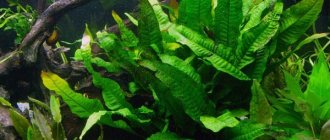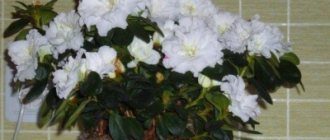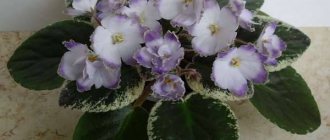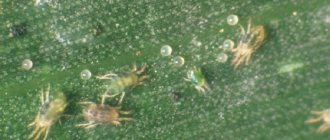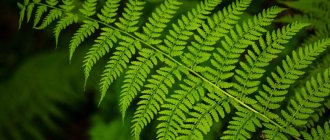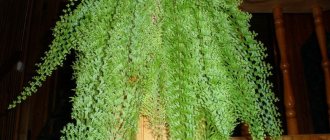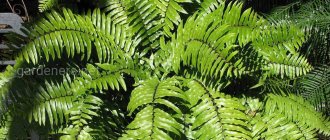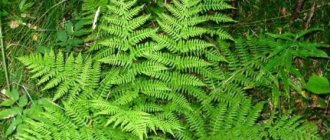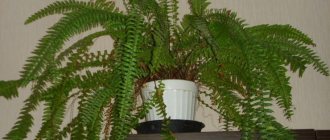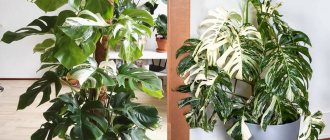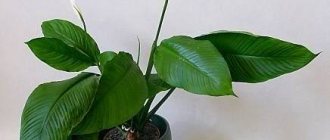The place of ferns in the plant world
Ferns belong to higher plants . They differ from lower ones by the presence of special organs:
- root;
- stem;
- leaves.
Higher ferniformes, in turn, are divided into:
- to vascular;
- to checkered or mossy.
Fern belongs to the first group, characterized by the presence of vascular-fibrous bundles . For example, in leaves these bundles are contained in the form of veins along which juices move.
Ferns are divided into two subclasses:
- real;
- water.
How many types of ferns are there in total? Real ferns are amazing in their diversity. We can say about them that some can look like moss and grow densely on the trunks of tropical trees, reaching a size of several centimeters. This variety is called epiphytes. Translated from Greek it means “on the plant.” Others can reach twenty-five meters in height and resemble spreading palm trees in their appearance. Castings can be several meters long.
Water ferns will be discussed below.
The editors of the site recommend that you read the description of the types of home succulents.
History of fern plant species
Ferns trace their history back to the time when there were dinosaurs on the planet. There was a favorable warm tropical climate then. Some species grew simply huge by modern standards - up to 30 m.
Types of ferns and their classification
Time passed, and the climate changed not for the better, as a result of which cataclysms occurred and the most ancient forms of the plant did not survive to this day. The modern branch of ferns is very different from its ancestors in both size and shape. The largest group consists of 300 genera, represented by 10,000 species.
On a note! These shrubs are widely used both in gardens and at home.
The tallest plants grow in climates favorable to them - tropical and subtropical. Some individuals grow up to 20 m.
The tallest ferns grow in the tropics
Reproduction and prevalence
In the absence of flowers, ferns reproduce using spores . Since this method was not known to science until the nineteenth century, the fern was called secretagogue. In addition to spores, the reproductive organs can be the so-called brood buds that develop on the leaves.
Most ferns—up to 3,000 species—are distributed throughout tropical forests . In total there are up to 4000 species.
Modern ferns are mostly herbaceous plants . In temperate climates, perennials with strongly developed roots grow.
Description of the plant
Natural habitat - shady forest valleys, trunks and branches of giant trees (epiphytic species), rock crevices, rivers, swamps and lake areas. The most unassuming species grow in field conditions and on roadsides.
More than 400 million years ago, ferns grew up to 40 m in height.
The main life forms of perennials are herbaceous and woody species. The tropical resident does not like excessive dampness and cold; waterlogging is also contraindicated for him, as is the scorching hot sun. The main conditions are a warm and humid climate.
The body of the plant consists of a leaf plate, a petiole, a shoot and a rhizome.
The root system (vegetative and adventitious) is thin and cord-like in structure. The shoots are epiphytic, creeping. Ferns with underground, short stem-roots live in temperate climates.
In a fern, what is commonly called a leaf is a system of branches that is located in the same plane. Hence the name - flat branch, pre-shoot or frond. Fronds are formed from the buds of the rhizome and reach large sizes. Preshoots participate in the process of photosynthesis and form spores.
The fronds are cut, openwork, curved in structure. They grow lushly and spreadingly. They reproduce vegetatively (by rhizomes, fronds, buds) or by spores (microbuds for asexual reproduction).
Homosporous ferns - types and names
Systematizing ferns is not an easy task. By the type of spores, they are homosporous, that is, their spores are of the same sex.
Homosporous, in turn, are divided according to the sporangium - the organ that produces spores. In some ferns it develops from one group of cells and is equipped with a single-layer wall, in others it develops from several and has a multilayer wall.
These are very ancient plant species that were widespread. Today there are approximately two hundred of them.
Comparison with other herbaceous plants
How does the life cycle of a fern go - stages of development and reproduction
The fern family also includes floaters and horsetails. But, despite the same method of reproduction, there are significant differences between most herbaceous plants and ferns:
- Ferns have a well-developed root system, the leaf structure is complex, while algae do not have this, their structure is simpler;
- the sporophyte predominates and the gametophyte phase prevails in mosses;
- Fern tissues are capable of conducting water, many plants cannot do this;
- the fern does not bloom.
Important! A number of scientists equate the process of sporulation in ferns with flowering. But nothing can be said for sure. There is a legend according to which the fern can bloom only once a year. A countless treasure awaits a person who sees a fern blossom. Usually this is a golden treasure. It can be dug up in the place where a flowering bush is found.
Fern is an amazing ancient culture. The first plants of this type served as food for dinosaurs; modern representatives of the fern family grow on windowsills and in gardens, in personal plots. Plants have a complex structure; there are no leaves, which are replaced by leaf blades. The stem is underground, the root system is well developed. A peculiarity of ferns is their lack of ability to form ovaries for subsequent flowering.
Ferns with multilayered sporangium
These include the grasshopper and marattiaceae families.
Among the first to be found in Russia are:
- common grasshopper;
- Key-grass.
The latter are common in the humid tropics, often in mountainous areas:
- angiopteris;
- macroglossum;
- Marattia.
Green grass family
Uzhovnikovye, pagan - these are Russian names. The literal translation from Latin is “snake tongue.” The shape of the leaves of this family is what gave these plants their name. They are divided in two and resemble a fork. Each part performs its own function. One is vegetative (reproduction through leaves), the other is fertile (spore-bearing).
About eighty species are known, the classification of which is combined into three genera:
- zhovnik;
- moonwort;
- helminthostachys.
Uzhovnikov are one of the most ancient groups of plants. They are very different from other types of ferns in their biological characteristics and occupy a rather isolated position. Uzhovnikovye - perennial plants, sometimes evergreen, small or medium in size. They prefer loose and moist soil and open areas. However, some tropical species, like moss, live on tree trunks in the dark corners of the rainforest.
The largest representative of the family is the pendulous grasshopper . In accordance with its name, it has drooping leaves that are two or even four meters long. But there are also very small plants - only a few centimeters long.
Uzhovnikov have stems, which for the most part are rhizomes that have emerged from the ground and stand at attention. They are thick and fleshy. The only exception is helminthostachys , which has horizontal roots. As a rule, branching of stems is not observed. The stems and leaves of ferns are soft and fleshy, unlike most ferns. Hairless roots usually contain lower fungi associated with them, the so-called mycorrhizal ones.
The leaves of the grasshoppers are very distinctive. They do not have the snail-like twisting characteristic of most ferns when they emerge from the bud. Another feature of the leaves is the presence of special sheaths that obscure the bud.
Basically, the grasshoppers produce one leaf every year, less often - four. Therefore, the number of leaf scars on the rhizome allows us to judge the age of the fern. Slow leaf growth is also a feature that characterizes snake tongues. The leaves fully emerge to the surface around the fifth year of their development.
In our country, grasshoppers are distributed in pine forests, where they are most diverse. These include, for example, multifidus .
Family Marattiaceae
There are more than 60 species. Although they resemble their tree-like counterparts, they are not. Marattiaceae sometimes reach very impressive sizes and are among the largest plants on Earth. But their size is determined not by the stem, but by five- and six-meter leaves. At the base they are equipped with stipules. The stems themselves are no longer than one meter, look like potato tubers and are almost half in the soil.
Marattiaceae, like grasshoppers, are distinguished by their originality. Their giant leaves have appendages at their base that do not disappear after falling. They not only protect the plant, but also accumulate starch. They are also intended for reproduction. They have buds that are at rest. When favorable conditions occur, the buds give birth to new ferns. The stems, leaves and roots of marattiaceae necessarily contain mucus ducts. They are long channels, separate cavities or cells and serve to preserve substances that are temporarily excluded from metabolism.
Angiopteryses belonging to the Marattia family live in shady swampy forests and gorges and are very numerous. Also found along roads and on river banks. Their huge leaves are double pinnate. In pinnate leaves, the leaf blades are located along the length of the main petiole. And bipinnates are divided twice, their plates are attached along the second petioles connected to the main petiole. The main and secondary petioles have thickenings at the joints. Thanks to this feature, the petioles are similar to a bamboo stem and have a thickness comparable to the thickness of a human hand.
Most of this family became extinct. Of these living fossils, only seven genera survive today. They live in tropical areas. Marattiaceae are often bred in greenhouses.
Caring for your house fern
Nephrolepis care at home involves systemic care. But there are no difficulties in growing herbaceous perennials. The main thing is to know about his preferences and give him due attention. Among the main points that are taken into account when growing a healthy fern are the following:
- pot selection;
- choosing the optimal location;
- watering and spraying;
- feeding and pruning.
Selection of pot
How to grow indoor fern - care at home
The underground part of Nephrolepis is compact. The rhizome spreads horizontally under the soil layer. In view of this, the pot for the fern is selected not high, but wide. In addition, it must be sustainable. The green mass of large varieties grows quickly. The tropical guest does not tolerate stagnant water. Therefore, the pot must have holes in the bottom. Otherwise, the rhizome will rot.
Additional Information. As for the material from which the flowerpot is made, it can be ceramics or plastic. Ceramic containers have optimal air exchange. Plastic retains the required amount of moisture.
Selecting a location
As soon as the fern is transplanted from a purchased pot into a personal home, it is placed in a permanent place. It is best to choose an area where there will be enough diffused light. Most varieties do not tolerate direct sunlight. Bright direct light burns tender leaves. The fern can be placed on a cabinet in a well-lit room, placed on a stand in the middle of the room or in the back of the room. Nephrolepis can be periodically turned in different directions towards a more illuminated area of the room.
The temperature should not be lower than +15 degrees. It is best if the house is warm enough - about +23...+27°C. In this case, the humidity should be at 60%.
The tropical bush does not tolerate drafts. This should be taken into account when ventilating the room.
Watering, spraying
Nephrolepis requires constant but moderate care in terms of watering. The owner of the flower picks up a watering can at least once every 2-3 days. In this case, the water should be at room temperature, settled. If the water is cold, a member of the Davalliev family may get sick. Watering goes to the root. Other variations are placing the entire pot in a bowl of water or pouring water into the tray of the pot.
Frequent watering for ferns is organized in the warm season. In late autumn and winter, the number of water procedures is reduced: to once every 10-14 days. However, the soil should not be allowed to dry out completely.
The same goes for spraying. Fern branches are responsive to irrigation with warm water. But only if the air temperature is at least +25 degrees. Spraying from a spray bottle is carried out once every 2 days in the summer. Thanks to this, the leaves become elastic and their color becomes bright.
Nephrolepis flower is responsive to spraying
Feeding and pruning
You should also care for your herbaceous perennial in terms of fertilizing. Organic mixtures are used. It is allowed to add mineral compositions. The main thing is not to overfeed nephrolepis. Fertilizers are purchased in specialized stores. They should be marked “for ornamental deciduous crops.” A small concentration is used at a time. If the instructions indicate that 5-6 g of the mixture should be taken per 1 liter of water, then for ferns no more than 2 g should be taken.
Important! Feeding is carried out once or twice a month from March to October.
Sanitary pruning involves removing branches that have begun to dry out. The procedure is performed as needed.
Soil selection
All types of nephrolepis prefer loose, light, fertile substrates. The acidity level should be neutral. A prerequisite when selecting soil for ferns is good breathability. Soil for nephrolepis is prepared from the following parts:
- ordinary soil (100 g);
- leaf soil (200 g);
- river sand (100 g);
- humus (100 g);
- turf (100 g).
Another option is to purchase a ready-made soil mixture. In this case, you should pay attention to bags of soil for ferns.
The soil should be loose and nutritious
Monosporangaceae: types of ferns, names and photos
The sporangia of this type of fern grow together into one whole, looking like a shell attached to a stalk. These include, in particular, polypodiums or centipedes and salviniaceae.
Polypodiums
Polypodiums are one of the largest fern families, comprising 50 genera and about 1,500 species. Their leaves are two-rowed, the roots are fleshy and covered with hairs. A characteristic feature of centipedes is the unusual crowded arrangement of sporangia on the leaves.
These are perennial plants covered with scales; their rhizomes are either creeping or upward. The leaves can be pinnate, doubly pinnate, or lobed - having cuts, consisting of several plates emerging from one point.
These plants are distributed mainly in the tropical zone of Eurasia. Most often they are classified as epiphytes and can grow on trees, rocks, and in the ground.
Water ferns - genus Salviniaceae
Salvinia is not so widespread. Its characteristic is that it refers to annual aquatic plants that grow close to the river bank or in a swamp and calmly float on the water. In appearance they resemble a four-leaf clover. Its most common genera are Marsilia and Salvinia. Their sporangia are located inside sporocarps.
Sporocarps are leaves or parts thereof that were greatly modified once upon a time, containing two or three groups of sporangia. They are located at the base of the leaf, have a grayish-brown color and are shaped like a bean.
Salvinia waterfowl has no roots. Found in the southern regions of Russia. Its stem is branched, covered with aquatic and aerial leaves. The leaves are whorled, located two or three on each node of the stem. Whorls of both types alternate with each other. First there are four rows of aerial leaves, and then two rows of water leaves. In accordance with their name, aerial ones float on the water surface, and water ones are immersed in it.
There is a variety of Salviniaceae called Azolla . It is also interesting for its structure. Azolla has a branched stem, on which there are two rows of leaves on the “back”, and one row of roots on the “abdomen”. Each sheet is divided into two halves, one of which is floating and the other is submerged.
Exotic varieties of fern
Due to the large number and diversity of ferns, many exotic, unusual species of this culture have become known:
- Nippon kochedednik, known for its unusually colored fronds.
Varieties:
- Pictum – purple branches;
- Silver falls – silver color;
- Ursulas red – purple fern.
- Platycerium (Deer Antler, Flathorn). A very unusual species, the fronds actually resemble deer antlers in shape, which is why they began to call it that.
Interesting! Thanks to their original and unique shape, colorful colors, and ease of care, ferns have won the love and respect of many gardeners. They are able to add variety and decorate any landscape.
1 1 vote
Article rating
